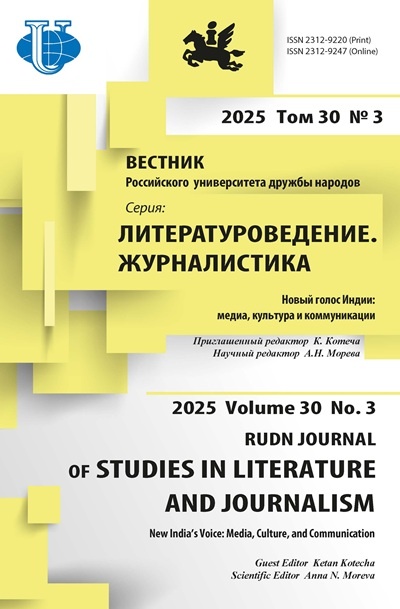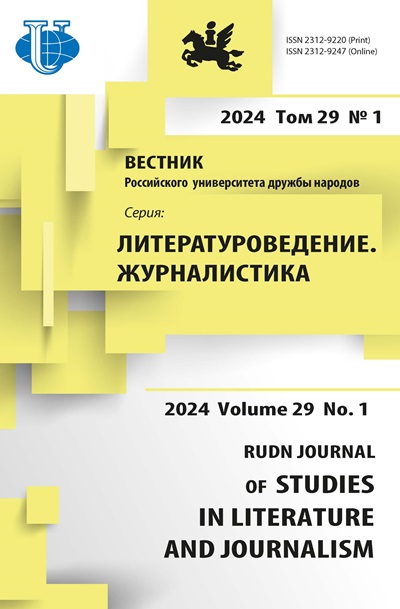Образ сердца в поэтическом и святоотеческом синтезе
- Авторы: Бычков Д.М.1, Гущина К.Н.2
-
Учреждения:
- Астраханский государственный технический университет
- Астраханский государственный медицинский университет
- Выпуск: Том 29, № 1 (2024)
- Страницы: 27-33
- Раздел: Литературоведение
- URL: https://journals.rudn.ru/literary-criticism/article/view/40022
- DOI: https://doi.org/10.22363/2312-9220-2024-29-1-27-33
- EDN: https://elibrary.ru/YWFIQA
- ID: 40022
Цитировать
Полный текст
Аннотация
Анализируется религиозно-философский и поэтический контекст функционирования образа сердца в дискурсе русских поэтов-символистов. Предпринята попытка обнаружить мифологические и христианские (евангельские и святоотеческие) корни в генезисе «кардиотопики». Авторы исследования опираются на широкий круг трудов отечественных богословов и философов. Кроме того, для более полной интерпретации образа привлекаются новейшие анатомо-философские концепции и отдаленные контексты (ведические и коранические). В работе применяется когнитивно-дискурсивный подход к анализу и интерпретации центрального образа «кардиотопики» - сердца. Делается вывод, что поэтическое и святоотеческое восприятие образа сердца обнаруживает парадоксальную конвергенцию смыслов: традиционная интерпретация образа как символа человеческой души, которая испытывает различные эмоции и переживания и передает глубокие мысли и чувства субъекта, сопрягается в поэтическом пространстве текста с речемыслительной и когнитивной функциями, осуществляющими коммуникацию с внешним и внутренним миром, с Творцом (Богом), а также сложный процесс интуитивного познания, реализованный стимулами различной модальности (памяти, рече- мышления, восприятия).
Ключевые слова
Полный текст
Введение
Речемыслительная функция сердца в русской поэзии восходит к анатомо-философским концепциям ведических мифов, Священных тестов, святоотеческой литературы, что в совокупности служит основанием для воссоздания генезиса образа сердца. Поэты-символисты начала XX в. расширили интерпретационный потенциал образа за счет включения присваиваемых ему когнитивных способностей еще и коммуникативной функции, что повлеклоза собой дискурсивную конвергенцию в прочтении образа сердца. В символической репрезентации сердце способно выражать глубинные чувства, эмоции и мысли поэта, а также служит передаче символического значения идеалов, ценностей и духовности.
Обсуждение
Чувственно-телесная топография демонстрирует центральное положение сердца как концептуального понятия в системе миропредставлений человека об ипостасях своей личности. Биомеханика и широкий спектр эмоцио-нально-чувственных и духовных переживаний человека осмысливается через «силу живого сердца». Сердце вздыхает, стонет, говорит, молчит, молится, «льет слезы и издает вопли», любит и радуется, страдает, жаждет, разумеет и понимает – вот лишь небольшой перечень действий, который интуитивно приписывается сердцу человеком. Этимология слова сердце (от индоевропейского корня kerd)1 предопределила его центральное положение в представлении человека о своем теле, его концептуальной картине мира и художественной соматосфере.
Поэтическая и философская семантика образа сердца мифологически связана с его анатомической формой. Как известно, сердце имеет конусообразный вид: основание расширено и обращено назад и вверх, образуя своего рода воронку, что нашло отражение в массовом бытовом сознании. Форма сердца как секулярный символ обычно изображается в виде двух выпуклых полукругов, соединенных внизу острым концом. Эта форма ассоциируетсяс физическим сердцем и является узнаваемой и универсальной.
Ведическая традиция приписывает воронке особый мистический статус – получать и аккумулировать разновекторные энергии – земную (материальную) и духовную (небесную). Ведические тексты описывают сердце как место, где пребывает душа и где происходит взаимодействие между материальным и духовным мирами. В ведической философии сердце также связывается с понятием «атман», или души. Считается, что в сердце находится истинная сущность человека, его внутренний свет и мудрость. Ведические практики, такие как медитация и йога, направлены на раскрытие этой внутренней сущности и достижение духовного просветления. Таким образом, в ведической традиции сердце имеет глубокий духовный смысл, связанный с самопознанием, преображением и единством с божественным. Оно является символом высших человеческих качеств и стремления к духовному развитию.
Такая изотерическая теория вполне коррелирует с анатомо-физиологической идеей о энергетическом обеспечении сердца, имеющим в основе химическую природу. Так, воронкообразное строение органа, расширенной частью направленного вверх по отношению к мозгу, способно принимать от него разной природы импульсы и сигналы, в том числе и те, которые не нуждаются в анатомических и физиологических способах связи. По этому поводу хирург и богослов В.Ф. Войно-Ясенецкий пишет: «…мысли передаются в сердце… мысль как акт чисто психологический, в отличие от ощущений как актов физиологических, не нуждается в анатомических путях проведения» (Войно-Ясенецкий, 2022, с. 42). При этом возможна и обратная передача от сердца к мозгу, уму.
Анатомо-физиологический субстрат образа сердца характеризуется также автоматизмом функционирования, то есть работа органа самообусловлена и имеет источником само себя. В художественном дискурсе эта функциональная специфика получила особый философский статус: ключевое положение среди других соматических органов, а также возможность замещать в образной структуре всего человека как личность. Таким образом, материальная основа образа объясняется его культурным статусом: сердце воспринимается как локализация духа и душевной жизни человека, локус концентрации духовной жизни субъекта.
Метафорико-ассоциативный спектр сердца как образа в художественном дискурсе коррелирует с фактами, описанными в медицинской литературе. Так, кардиолог А.И. Гончаренко отмечает два удивительных факта о физиологическом поведении сердца. Первый факт – «предвосприятие» этого органа, при котором перцептивная способность сердца опережает наши ощущения и работу сознания. Второй факт – это этический потенциал органа, его «моральное поведение», заключающееся в способности «жертвовать» кровью ради спасения других органов (Гончаренко, 2004, с. 34–43).
Святоотеческая традиция также приписывает сердцу широкую функциональную дифференциацию, далеко выходящую за пределы традиционной анатомии и физиологии: «Сердце, по Священному писанию, есть орган общения с Богом, – пишет В.Ф Войно-Ясенецкий в своем сборнике поучений „Дух. Душа. Тело“, – оно есть орган высшего познания» (Войно-Ясенецкий, 2022, с. 24). Действительно, труды христианских богословов – Ефрема Сирина, Григория Богослова, Василия Великого, Иоанна Лествичника, Макария Великого и многих других отмечают речемыслительную функцию сердца, способную к мистической коммуникации. «Все тела в совокупности не могли бы произвести самой ничтожной мысли: это невозможно, это явление иного порядка. Из всех тел и умов нельзя было бы извлечь ни одного движения истинной любви: это невозможно, это явление иного порядка, это – выше природы», – писал Блез Паскаль, также полагая, что сердце способно к иррациональному восприятию и переработке экзогенных импульсов нематериальной природы интуитивным «чутьем», способно к аккумуляции духовной энергии, «это сверхприродное событие происходит именно в сердце» (Тарасов, 2006).
Генезис образа сердца в христианской традиции восходит к Священным писаниям, для которых характерна метафорическая корреляция сердца и поля. Например, в евангельской «Притче о сеятеле» (Матф. 13:3–8) рассказывается о том, как сердца людей воспринимают Слово Божие. При этом сердце ассоциируется с почвой, землей, дорогой (каменистой, тернистой и доброй). Слова Иисуса Христа проникают в душу через сердца.
Подобное представление о сердце наблюдается и в исламской традиции: сердца неверующих уподобляются недужным, запечатанным, каменным. В Суре 2:10 читаем: «Их [неверующих. – Д.Б., К.Г.] сердца поражены недугом. Да усилит Аллах их недуг!». Таким образом, религиозная интерпретация данного образа определяет сердце органом, воспринимающим и аккумулирующим духовные законы Творца.
Христианство наделило сердце новой функциональностью – коммуникативной. В Евангелии от Матфея есть строки, раскрывающие когнитивно-коммуникативные возможности сердца: «От чистого сердца глаголят уста» (Матф. 12:34). Если тело суть необходимое – топос связи с земным, материальным миром, то сердце – это канал связи, коммуникации с миром Божием. Философ И.А. Ильин писал: «…земной язык не имеет для этих обстояний верных слов и отчетливых представлений, а сверхземному языку я еще должен самостоятельно научиться, то есть приобрести его, или (еще точнее) творчески создать его в себе, чтобы понимать его и владеть им» (Ильин, 2013, с. 242). Говоря другими словами, в сердце сосредоточиваются грани структуры личности – духовной, душевной и физической, при этом сердцу отводится роль коммуниканта между указанными личностными планами. С другой стороны, это орган чувств, которым приобретается духовный опыт, и продолжая словами И.А. Ильина, «в этом опыте я должен пережить и увидеть мое собственное духовное естество и добыть себе очевидность моего духовного бессмертия» (Ильин, 2013, с. 242).
В русской поэтической традиции Серебряного века (в особенности поэты-символисты и акмеисты (Гущина, 2023)), перекликающейся с религиозно-философским дискурсом, относительно интерпретации исследуемого понятия кардиотопика приобретет более отчетливое коммуникативное измерение, сродни фразеологическим оборотам – говорить в сердцах, сердечный разговор, от сердца к сердцу, от чистого сердца, воспринимать близко к сердцуи т. п. При этом кардиотопика достаточно часто сопрягается с традиционными романтическими образами (луны, звезд, тумана) и мотивами (одиночества, молчанья). Так, А.А. Голенищев-Кутузов в стихотворении «Когда святилище души…» (1888 г.) репрезентует образ сердца вместилищем глубоких размышлений лирического субъекта, где созревает до времени его эмоционально-волевая сфера и аккумулируются душевные порывы, готовые в нужное время «взорваться»:
В глубоких недрах вспыхнет жар,
И тьму пронижет луч победный,
И грянет громовой удар!2
Или же в стихотворении «Не смолкай, говори…» (1888 г.), в котором влюбленное и одурманенное сердце лирического героя коррелирует с онейри-ческими мотивами сна, мечтания и представляется вместилищем дум и размышлений. Лирический субъект поэта находится на пути духовного познания природы одиночества человеческой души. В данном контексте сердце отождествляется с миром, непознаваемым, полным тоски и отрешенности от диалога.
Речемыслительная функция сердца, как видим, замкнута на самой себе, поскольку достойного субъекта общения в душевном плане ему не найти. Вся полнота общения человека доступна только Творцу. Говорить сердцем человек может только с Богом, и русские поэты видят в этом источник человеческих страданий.
В русской поэзии начала XX в. речемыслительная и коммуникативная функция сердца часто выражается через символическое изображение сердца как центра эмоционального и духовного мира человека. В поэтическом дискурсе сердце часто ассоциируется с понятием «душа», выступая как источник чувств и эмоций, неразрывно связанных с внутренним миром поэта. Оно выражает его внутреннюю правду, его самые глубокие переживания и мысли.
В современной филологии утвердился ряд представлений, «связывающих ментальные и физические феномены. Они должны быть включены либо в сферу материального, либо в сферу ментального, однако с точки зрения своих носителей они не могут принадлежать ни к одной, ни к другой области»3. Сердце также часто используется как репрезентант когнитивных свойств лирического субъекта. Особое значение этому предавали романтики XIX в. и русские символисты Серебряного века в силу их трансцендентного мировосприятия, репрезентованного в лирических текстах. Например, в стихо-творении А. Блока «Тревога» образ сердца способен слышать, видеть, декодировать тайные знаки, все это – совокупность коммуникативных параметров образа:
Сердце слышишь…
Сердце видишь:
Кто-то подал знак,
Тайный знак рукой?
(Блок, 2009, с. 216)
В этом плане образ сердца восходит к романтической интерпретации. К. Батюшков в стихотворении «Мой гений» (1815 г.) указывал на еще одно когнитивное свойство сердца, без которого невозможна коммуникация, – память:
О, память сердца! Ты сильней
Рассудка памяти печальной…4
Заключение
Итак, человеческому сознанию свойственна мифологизация окружающего мира как попытка объяснить сложные универсалии не только внешней действительности, но и внутреннего бытия личности, в том числе и анатомо-философского представления о теле, трансформирующего физиологическоев мифологическое. В этой связи особым значением наделяется образ сердца как ключевой топос в телесной концепции поэтов и философов. Представляется интересным рассмотреть мифопоэтический генезис данного образа в его связи с материалистической интерпретацией. Современная философская и филологическая мысль активно обращается к интерпретации образа сердца. Когнитивные функции сердца в поэзии заключаются в использовании образа сердца для передачи мыслей и идей, связанных с различными аспектами человеческой жизни. Сердце может быть использовано как символ чувственности и эмоциональной глубины, который помогает поэту передать свои мысли и идеи в более яркой и выразительной форме. Поэтическая гносеология приписывает сердцу познавательные способности, реализующиеся в различных модусах перцепции – памяти, речемышлении, интуиции, коммуникации и др.
1 Багриновский Г.Ю. Этимологический словарь русского языка: более 5000 слов. М.: Астрель: АСТ, 2009. С. 555.
2 Голенищев-Кутузов А.А. Стихотворения. URL: http://az.lib.ru/g/golenishewkutuzow_a_a/text_0020.shtml (дата обращения: 27.11.2023).
3 Когнитивный словарь литературно-философского дискурса / ред.-сост. Е.Н. Бадалова, Д.М. Бычков. Астрахань: Астраханский государственный университет: Астраханский уни-верситет, 2014. С. 201.
4 Батюшков К.Н. Стихотворения. URL: http://az.lib.ru/b/batjushkow_k_n/text_0080-2.shtml (дата обращения: 01.12.2023).
Об авторах
Дмитрий Михайлович Бычков
Астраханский государственный технический университет
Email: dmitriybychkov@list.ru
ORCID iD: 0000-0002-0114-7341
кандидат филологических наук, доцент кафедры иностранных языков и речевых коммуникаций
Российская Федерация, 414025, Астрахань, ул. Татищева, д. 16Ксения Николаевна Гущина
Астраханский государственный медицинский университет
Автор, ответственный за переписку.
Email: k.churzina@yandex.ru
ORCID iD: 0000-0002-7235-6263
кандидат филологических наук, доцент кафедры русского языка
Российская Федерация, 414000, Астрахань, ул. Бакинская, д. 121Список литературы
- Блок А.А. Полное собрание стихотворений: в 3 томах. Том второй (1904-1908). М.: Прогресс-Плеяда, 2009. 307 с.
- Гончаренко А.И. Непознанное сердце // Техника молодежи, 2004. № 9. С. 34-43.
- Гущина К.Н. Поэтика телесности в лирическом творчестве Владимира Нарбута: монография. Астрахань: Изд-во АГТУ, 2023.92 с.
- Ильин И.А. Поющее сердце. Книга тихих созерцаний. М.: ДАРЪ, 2013. 320 с.
- Свт. Лука (Войно-Ясенецкий), археп. Симферопольский и Крымский. Дух, душа и тело: избранные поучения. М.: ДАРЪ, 2022. 320. с.
- Тарасов Б.Н. Философия сердца в творчестве Паскаля и русских мыслителей // Вестник русской христианской гуманитарной академии 2015. Т. 16. Вып. 3 С. 229-237.
Дополнительные файлы















